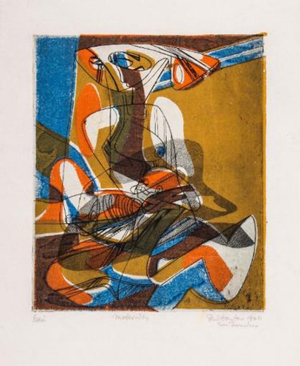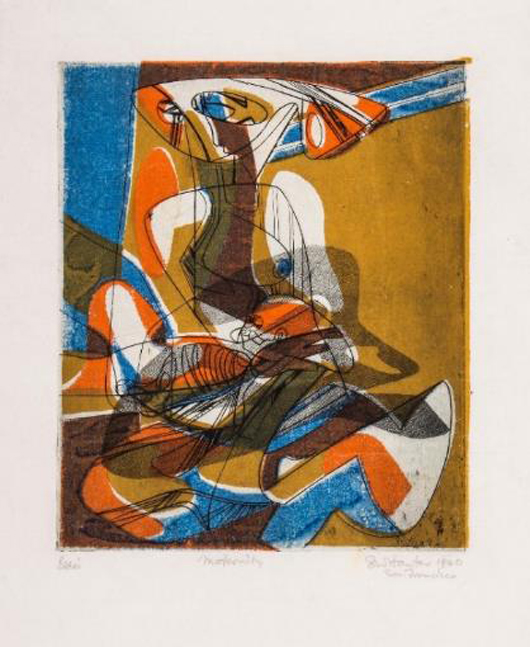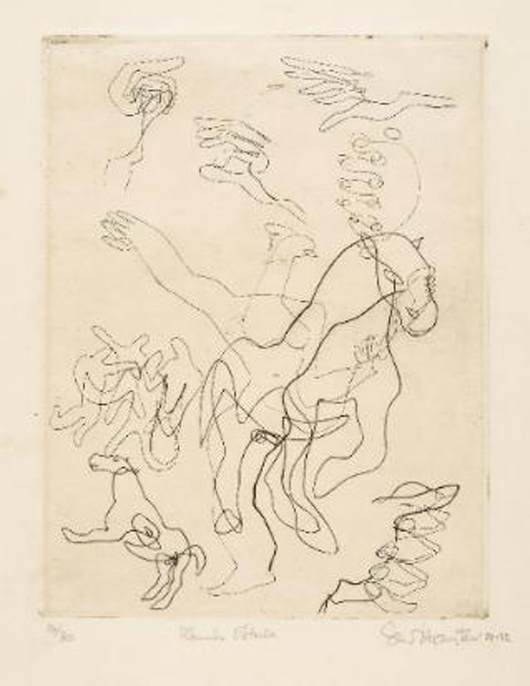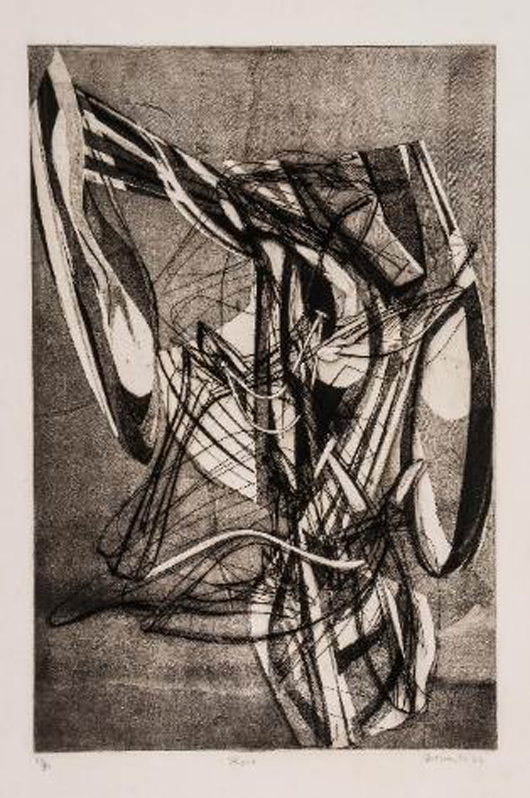Stanley William Hayter (1901-1988) ‘Maternite,’ engraving with soft-ground etching and screenprint in colors, 1940, signed, titled and inscribed. Est. £700-£900. Bloomsbury Auctions image
In one the largest and most extensive assemblages of Stanley William Hayter works to date, Bloomsbury Auctions is offering for sale 92 of his pieces, spanning paintings, drawings and prints. The auction comes after “Conscience and Conflict: British Artists and the Spanish Civil War” opened at Pallant House Gallery. The exhibition delves into the relationship between the Spanish Civil War and British Surrealist artists. It demonstrates how Hayter’s Parisian studio, Atelier 17, was the epicentre of the European Surrealist movement, from which artists created works imbued with the political and social impact of war. Bloomsbury Auctions’ Stanley William Hayter Painter-Printmaker auction builds on these themes by exploring Hayter’s artistic output throughout his life. The pieces show an artist molded by conflict and trace his technical development from an untrained science graduate to one of the greatest and most influential printmaker’s of the 20th century.
“Hayter’s interest in Jungian psychology and the concepts of the personal unconscious and automatism became vital to his creative output – allowing images from his subconscious to develop without conscious direction in front of him, be it on paper, canvas or copper plate. To him, whatever medium was to hand was the vehicle onto which he could project this stream of consciousness … it was all one work, one life-long artistic endeavour,” said Angus Maguire, head of modern and contemporary at Bloomsbury Auctions.
After graduating from King’s College in Chemistry and Geology, Hayter joined Anglo-Persian Oil, working in Iran from 1922-25. Although removed from the artistic world, Hayter painted and drew portraits of his colleagues, and in 1925, while recovering from malaria, he exhibited a collection of these works at the company’s headquarters. It was the commercial success of this exhibition that saw Hayter turn his back on the oil industry and move to Paris to study and pursue a career in art.
This collection offered for auction tracks Hayter’s artistic career through a natural evolution of his style. It opens with prints from his early years in Paris, that include Planche d’Etude, 1928-32, produced around the time he opened Atelier 17, a studio that would become a powerhouse of innovatory color printing and attract the most famous of avant-garde artists working in Paris.
The horrors of the Spanish Civil War drove artists such as Kandinsky, Miro and Picasso to join Hayter at Atelier 17 to work on prints for two collaborative portfolios Fraternité and Solidarité. Prints from both of which can be found in the sale. Both portfolios were created to raise funds to support the Republican cause in the Spanish Civil War [Lot 11 and 20].
With the outbreak of World War II, Hayter moved to New York and undertook the role of teaching printmaking at the New School where he acted as an artistic catalyst, nurturing the next generation of artists. Works from Hayter’s early days in New York include a rare group of three state proofs for Persistence of Life, that explore Hayter’s artistic process [Lot 32] and his celebrated print Flight recognizable as the image used for the catalog cover of the seminal Hayter and Studio 17 exhibition at the Museum of Modern Art, New York, 1944 [Lot 38].
Hayter’s studio became known for its highly experimental approach to print making. Influenced in part by Hayter’s petro-chemical knowledge, it was here that the process of viscosity printing was developed.
This revolutionary technique produced works such as Maternite, Hayter’s first color print, which depicts his then wife, Helen Phillips, cradling their newborn son Augy [Lot 21].
Hayter returned to Paris in 1950 where he continued to develop his viscosity technique until his death in 1988. His studio was a hub of activity and experimentation, filled with students from all over world, who had come to learn the skills that had been developed in collaboration with the most famous artists of the 20th century.
Hayter’s ground-breaking prints, offered in the sale, are interspersed with larger paintings spanning a variety of media. Highlights include Untitled, 1946, [Lot 49] and Ceres, 1948 [Lot 53].
The collection explores the diverse and experimental career of the most complex printmaker of the 20th century, an innovator who developed ground-breaking techniques and who is often overlooked.
ADDITIONAL LOTS OF NOTE
Stanley William Hayter (1901-1988) ‘Maternite,’ engraving with soft-ground etching and screenprint in colors, 1940, signed, titled and inscribed. Est. £700-£900. Bloomsbury Auctions image ‘Archer, 1948,’ oil on canvas, signed and dated at lower right, [Lot 52]. Est. £10,000-15,000. Bloomsbury Auctions image ‘L’Apocalypse,’ 1931, complete set of six engravings four with drypoint, each signed in pencil, [Lot 4]. Est. £3,000-5,000. Bloomsbury Auctions image ‘Planche d’Etude, rare engraving, 1928-32, signed, titled, and dated in pencil, numbered 14/30. Est. £800-£1,200. Bloomsbury Auctions image ‘Flight (B.&M.159),’ engraving with soft-ground etching and scorper, 1944, signed, titled and dated in pencil, numbered 28/30. Est. £700-£900. Bloomsbury Auctions image
![‘Archer, 1948,’ oil on canvas, signed and dated at lower right, [Lot 52]. Est. £10,000-15,000. Bloomsbury Auctions image ‘Archer, 1948,’ oil on canvas, signed and dated at lower right, [Lot 52]. Est. £10,000-15,000. Bloomsbury Auctions image](https://www.liveauctioneers.com/news/wp-content/uploads/2014/11/2014_1119_dbimage003.jpg)
![‘L’Apocalypse,’ 1931, complete set of six engravings four with drypoint, each signed in pencil, [Lot 4]. Est. £3,000-5,000. Bloomsbury Auctions image ‘L’Apocalypse,’ 1931, complete set of six engravings four with drypoint, each signed in pencil, [Lot 4]. Est. £3,000-5,000. Bloomsbury Auctions image](https://www.liveauctioneers.com/news/wp-content/uploads/2014/11/2014_1119_dbimage004.jpg)



